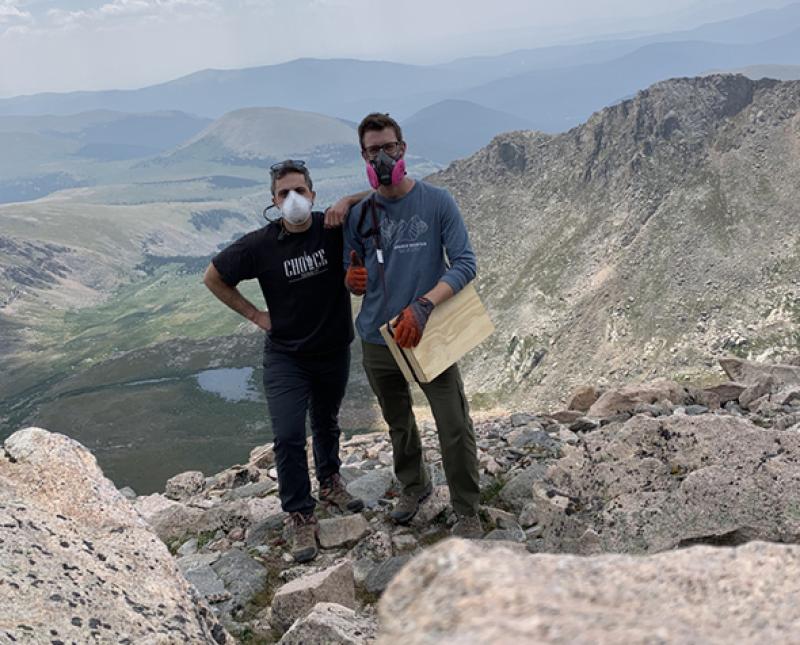NIH Grant Powers Evolutionary Research to Aid Health at High Elevations

Researchers Jonathan Velotta and Peter Nimlos pause for a picture while conducting field research.
For mammals accustomed to lower elevations, the changes when they enter a hypoxic environment—above roughly 2,500 meters (8,202 feet)—can be swift and severe.
The vessels inside the lungs constrict, blood becomes more viscous and the heart works harder to supply other organs. The kidneys and adrenal glands can also become altered. More than 140 million humans worldwide live in such environments, with various evolutionary mechanisms helping them overcome the challenges, but a better understanding of those changes can aid researchers in a whole host of fields.
At the University of Denver, a grant of just over $1.8 million from the National Institutes of Health will fund the research of Dr. Jonathan Velotta and his team at the College of Natural Sciences & Mathematics as they use both lab and field work to study the effects of hypoxic environments on deer mice (Peromyscus maniculatus).
As an evolutionary biologist, Velotta says one key focus is how animals evolve to meet the challenges presented by extreme environments and the genetic basis behind that.
“In the broadest of strokes, we’re trying to understand organisms and how they live at extreme altitudes—the primary challenge being there is extremely low oxygen availability,” Velotta says. “There are millions of humans living in what we would consider to be high altitude, and some are more subject to the diseases that we associate with high altitude than others. A lot of that depends on how long different peoples have been evolving in high altitudes.”
Deer mice are used as a model for Velotta’s studies because they’re found from sea level to the highest mountain summits in North America and can be used in detailed experiments. The mice from low elevations, which Velotta calls “lowlanders,” are gathered from Nebraska. The “highlanders” hail from the summit of Mount Evans, which can be accessed by road and features a handful of University of Denver facilities. The team uses a cabin that once housed observatory workers as a makeshift lab to serve on-site needs.
While working in the field, the team stays at the University’s high-altitude lab at Echo Lake near Evergreen to be closer to Mount Evans. Mice from both groups are also kept in a vivarium on campus and are reared for a few generations to observe any genetic changes. Aspects like body heat maintenance, particularly in high-elevation environments where it’s cold, are studied closely, with comparisons made between evidence gathered in the field and in the lab.
“It’s a lot of time being outside, working hard at high altitude—and it’s a lot of fun,” Velotta says of the field work.
The team features three graduate students (Lacey Conrad, Riley Corcoran and Peter Nimlos), a lab technician (Emma Glenn) and two undergrad students (Nicole Choi and Braeden Strong). The University of Denver group collaborates with other researchers, including Kelsie Hunnicutt and Erica Larson at DU, Zac Cheviron’s lab at the University of Montana, Graham Scott and Grant McClelland at McMaster University in Canada, Jay Storz at the University of Nebraska and Kate Wilsterman at Colorado State University.
The grant was awarded in August 2022, so research is just ramping up on the project. Recently, the team has been focused on taking mice from high and low altitudes and placing them in hypobaric chambers that simulate hypoxic environments. Even though the level of oxygen in the air is 21% regardless of elevation, the low pressure in high-altitude environments causes those oxygen molecules to be more spread out and less available to the animal.
In that simulated space, the mice are reacclimated to the equivalent of the summit of Mt. Evans, and the team closely monitors their protective responses. Although the mice are able to handle the elevation, the way they respond can be detrimental to their health. Studying these responses can help researchers have a better understanding of human health at higher elevation and the evolutionary responses across generations.
Beyond the work for the NIH, which is focused on the potential impact on human health, the team is also mapping the genome sequences of animals in hypoxic environments to have a better understanding the specific genes that help them at high elevations.
“The animals that live at high altitude, they do not have a lot of the same responses you see in lowlanders,” Velotta says. “They don’t vasoconstrict [their blood vessels don’t tighten], they don’t have as much hypertension, they don’t create as many red blood cells, their heart muscles aren’t hypertrophied [excessively large]. Even the progeny of animals born at lower elevation don’t have that response to hypoxia because they don’t experience that level of oxygen in the same way. That’s probably because they’ve developed other mechanisms to bring in oxygen more efficiently. They breathe more efficiently, for one. Their muscles are better at taking-in oxygen. We’re interested in the mechanisms that physically change these things.”
Further research could potentially be applied at DU’s Kennedy Mountain campus, where a proposed mouse enclosure could allow researchers to more closely study the natural selection of mice in high-elevation environments.
“We drive low-elevation mice up to the campus, which at the highest point is somewhere around 9,000 feet,” Velotta says. “We individually tag the mice, measure all the traits we want and see who the survivors are. From that, we can measure fitness and natural selection in an experimental context. We take what we’ve learned, genes that we’ve found for example, and see whether the survivors have that gene or not. That’s the best evidence that that gene is driving natural selection. That’s experimental evolution, in a sense.”



